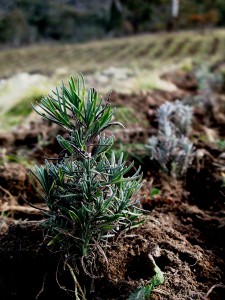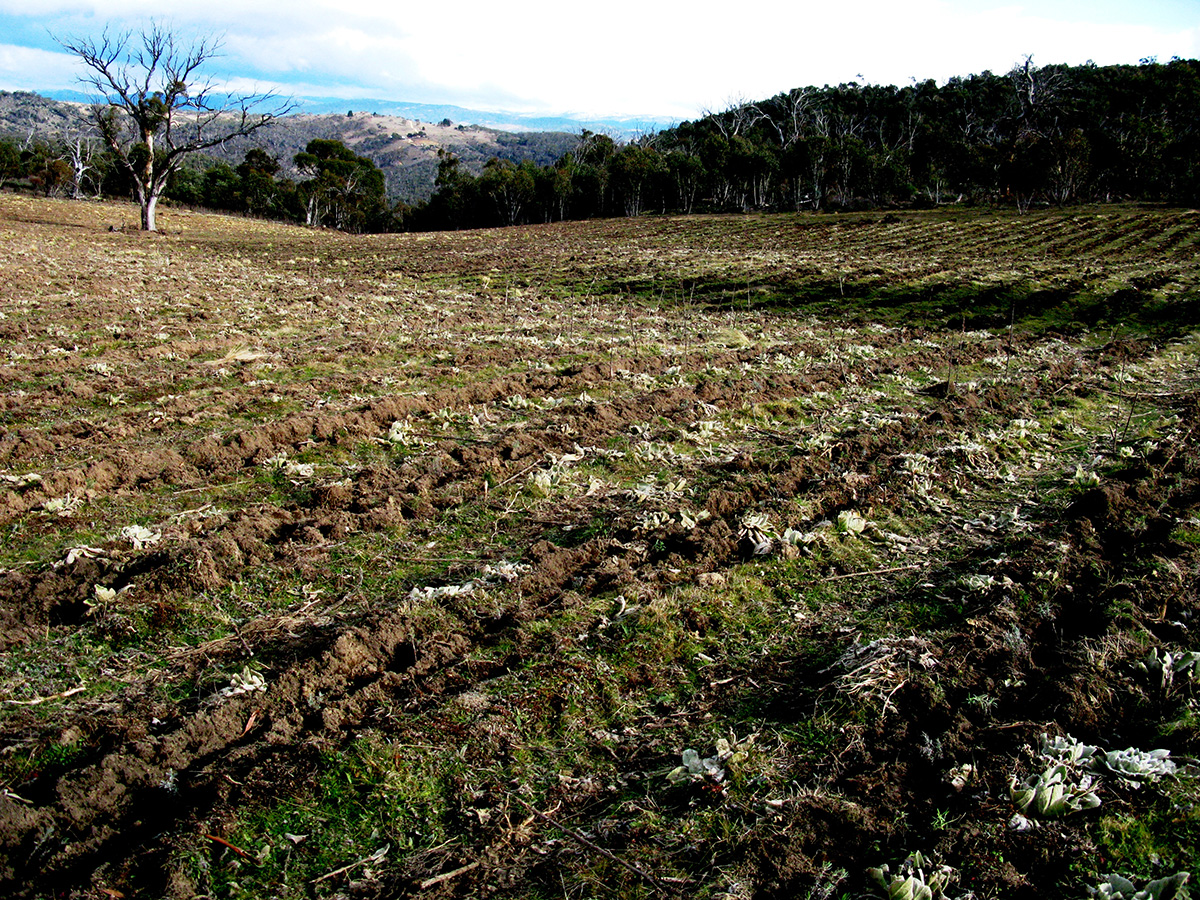
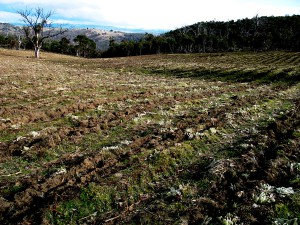 Minimum tillage and respecting vegative cover is a key tenant of ‘living soil’ approaches to farming. Excessive cultivation leads to the breakdown of soil structure which rapidly leads to compaction and infertility. ‘Goat Valley’ is our largest planting area and it came to us in degraded condition which we are working to restore. Cultivation for planting simply involves the deep ripping of the planting rows, spraying out of bio-dynamic preparations to encourage biological activity before the plants are settled in the rows for their life on the farm. Existing vegetative covered is retained between the rows as a permanent and living source of organic matter above and below the soil surface.
Minimum tillage and respecting vegative cover is a key tenant of ‘living soil’ approaches to farming. Excessive cultivation leads to the breakdown of soil structure which rapidly leads to compaction and infertility. ‘Goat Valley’ is our largest planting area and it came to us in degraded condition which we are working to restore. Cultivation for planting simply involves the deep ripping of the planting rows, spraying out of bio-dynamic preparations to encourage biological activity before the plants are settled in the rows for their life on the farm. Existing vegetative covered is retained between the rows as a permanent and living source of organic matter above and below the soil surface.
ESSENTIAL OILS, BORN OF THE EARTH
Essential oils are concentrated aromatic substances derived from plants and this origin in the plant world means that all essential oils have their start in ‘the soil’. How each plant’s relationship to the soil is nurtured is a pivotal question of most farming practice (hydroponics being the obvious exception), with the methods chosen, fundamental to qualitative difference in how plants grow and what they produce. These qualitative differences relate directly to how the plant is allowed to take up nutrients and how it relates and contributes to the environment in which it grows. At Snowy River Lavender we farm for a ‘living soil’ sustained through nurturing the ‘natural’ ecology of the landscape in which our farm is situated. We believe this approach and the soil culture it allows gives our essential oils their own unique signature of quality.
FARMING FOR A LIVING SOIL
In simplified terms a ‘living soil’ approach to farming falls under a broad rubric of beliefs and practices termed as, biological, ‘natural’, ecological, ‘organic’ and ‘biodynamic’ and while in practical terms all these titles do denote significant differences from one another, they nevertheless are all methods of practice which have as a central tenant the concept of a ‘living’ or biologically active soil.
- A ‘living soil’ is seen as a complex ecology of life forms which includes both macro- and micro-biology and is one sustained through an ongoing cycle of growth and decay constantly feeding back into itself.
- Importantly, in a ‘living soil’ approach plants are seen to take up their mineral nutrients in soluble form through organically produced colloidal matter known as humus, a natural form of feeding for which plants have specially adapted root systems.
- Soil minerals are assessed in terms of plant availability not simply by what minerals are materially present in the soil as is shown in soil tests.
- The plants humus feeding root system is different to their moisture uptake roots. Soil roots not only take from the soil, but are also instrumental in feeding back into the soil, both in terms aeration and organic matter, in an ongoing cycle of soil building and structuring biological activity.
- Humus has the ability to hold 75% of its own weight in water. It follows that soils high in humus have a natural resilience to drying out making them efficient consumers of moisture and less dependent on artificial irrigation.
- In this concept the plant and the soil form a synergy from which neither can be extracted without the detriment to the other. This has repercussions in styles of soil cultivation, with desired methods working towards maintaining soil structure and minimising tillage.
- Through photosynthesis the plant world is seen as linking the ethereal sphere of sunlight, air, weather, climate, seasons, to the earthly ecology of minerals and biological growth and decay. Plants are the key in the carbon cycle.
- Farming in this context is about nurturing and managing to sustain the balance of life forming activity while nevertheless still taking something out of this system in terms of farm production.
- Ref. A. Podolinsky, Biodynamic Agriculture Introductory Lectures Vol. 1, Chpt.1 Introduction: Soil, p.17- 36 Edition #6 2004, Gavemer Australia.
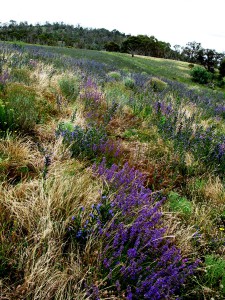
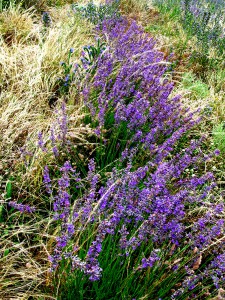
Young lavenders grow happily on ‘Shearers Slope’ among the summer grasses and field flowers. Biodiversity is important to a ‘living soil’, with the growing field conceived as a zone of plant co-operation in building an active and balanced soil. The specific methods of bringing the benefits of biodiversity into the growing field will vary according to individual farms and the crop being grown. With lavender, as a perennial crop we discretely control inter-row vegetation by way of mowing and hand pulling plants directly affecting the lavender at harvest time. Nothing is taken from the field but allowed to lie as mulch eventually to rot and be recycled into the soil. This contrasts to inorganic agriculture where the growing field is conceived as a competitive zone with soluble minerals in the form of expensive fertilisers, finite, and ongoing inputs meant only for the commercially productive plants. All other plants are weeds and must be controlled for usually by way of cultivation and herbicides.
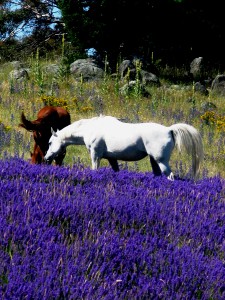
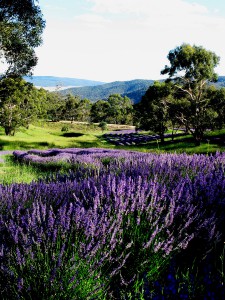
FOR COMPARISON; ‘INORGANIC’ SOIL FERTILITY
Justus Von Liebig’s book, Organic Chemistry and its Application to Agriculture and Physiology,published 1840, set in motion understandings which laid the foundations of modern agriculture as a system which could be nurtured inorganically. Leibig’s discovery, that plants ‘use elements if they have been made water soluble’, allowed plant nutrition to be gauged in terms of isolated mineral values divorced from a ‘vital source’ such as that represented by organically derived humus. It was his belief, that organic and inorganically derived nutrients are materially the same and that the inorganic nutrient due to its ability to be measured, quantified and manipulated could be more efficiently used to increase agricultural production. Out of this seminal work, agriculture has since developed, globally, on the central efficacy of artificially synthesised fertilizers, with a special emphasis on, the balance of key nutrients; nitrogen (N), phosphorous (P) and potassium (K). Some issues important to this inorganic approach to soil fertility:
- Plants in this system take up their nutrients in the form of soluble mineral salts (e.g. phosphate, sulphate etc) which are taken up through the same plant root system as the plant’s moisture up take and away from its natural propensity to develop soil humus feeder roots. Plants feed and drink by way of the same system where as for organically grown plants these are largely separately catered for processes.
- The dependency of plant feeding on soluble minerals means artificial irrigation is often the necessary accompaniment to this inorganic form of feeding.
- While soil biology is not denied in this approach it becomes secondary to a concept of soil as a medium reliant on the controlled input of industrially produced nutrients in the form of fertilisers.
- Centrally important in this approach is that the farm system is an intimately controlled and manipulated sphere where the plants access to nutrients is designed to obviate measured deficiencies in the farm’s natural environment for the purpose of optimizing and making predictable farm production.
- What is significant to this ‘input’ system of farming is that the plant’s relationship to the soil is changed from one where it is integral to its own fertility cycle to one where it is part of a cycle of dependency.
- Because plants lose their centrality in the life building cycle of the soil the important soil structuring and aerating they do is lost and mechanical cultivation is used to suffice. Over time this leads to soil compaction and loss of organic matter. The cycle is broken.
- Biodiversity is lost in this system of production, both on the level of the cropped plant, where species diversity is sacrificed for mono-cultures of high yielding and qualitatively standardised cultivars and seed strains (including GMOs); and, also extra plants in the farming environment which are vested as weeds and problems.
- Modern agriculture has developed mainly by way of this inorganic approach to soil fertility and it has been economically productive for many years, mainly because it has allowed industrial scale farming to flourish. Indeed, there is doubt that current mass levels of demand fuelled by wasteful cultures of consumption for agricultural products can now be supplied by any other method.
- However, currently, there are questions on many levels of the long term sustainability of this form of agriculture including:
- the impact on the broader environment, both land and water and in particular the oceans, due to the leaching in of excess nutrients and chemicals.
- as the soil loses its natural life force the traditional areas of permanent plant activity such as control of salinity and soil structure (compaction) is challenging the long term fertility of our soils and leading to irreparable degradation and desertification.
- surprisingly, even the economic viability of such high input forms of production are being questioned due to associated vulnerability of soils perpetually dependent on inputs.
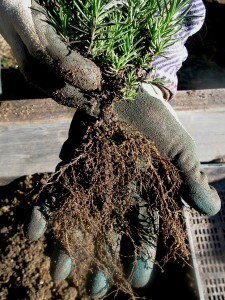 The root system, on this 12 month old lavender seedling, displays the fine network of soil feeder roots so critical to soil life. It is these fine roots, as they perpetually grow and die which both, feed the soil biology living amongst them to create humus; but also create soil structure as a constantly changing network of aerobic channels. As Biodynamic pioneer Alex Podolinsky presents without these aerobic channels, soil loses its architecture, its form, like a building reduced to rubble. Structure is as much the space between as it is the material which defines it. It is more than a sum of its parts. (Ref. Biodynamic Intro Lectures Vol 1 p. 21)
The root system, on this 12 month old lavender seedling, displays the fine network of soil feeder roots so critical to soil life. It is these fine roots, as they perpetually grow and die which both, feed the soil biology living amongst them to create humus; but also create soil structure as a constantly changing network of aerobic channels. As Biodynamic pioneer Alex Podolinsky presents without these aerobic channels, soil loses its architecture, its form, like a building reduced to rubble. Structure is as much the space between as it is the material which defines it. It is more than a sum of its parts. (Ref. Biodynamic Intro Lectures Vol 1 p. 21)
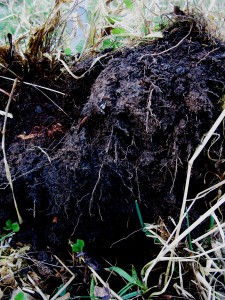
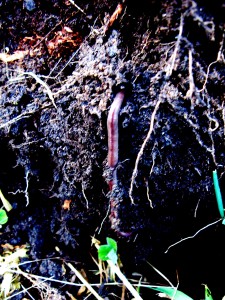
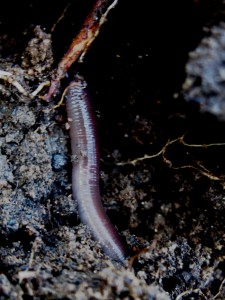
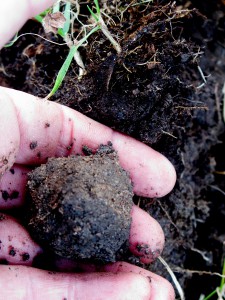
A broken sod of earth shows the fine network of soil feeder roots. These roots define the sub-surface limits of biological activity and index topsoil depth. In soils constantly under cultivation these life sustaining roots are turned and fine aerobic structure burnt away leading to soil compaction and erosion. Worms are a good indicator of soil life and are primary agents in turning microbial decayed organic matter into plant sustaining humus. Humus is colloidal in nature and its presence is discernible when the compressed soil holds together, as this small ball shows.
